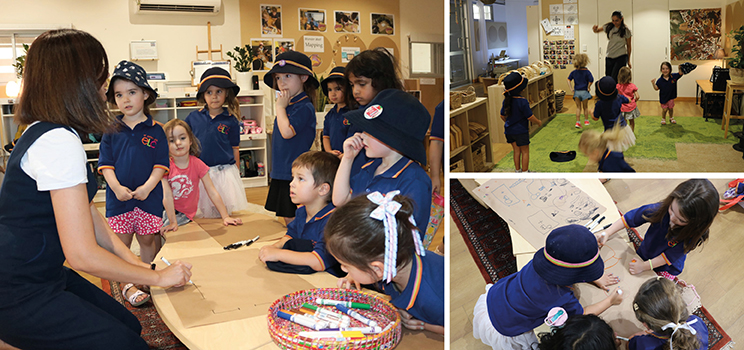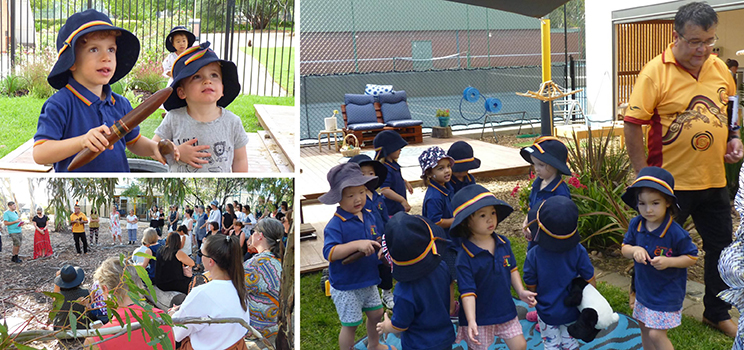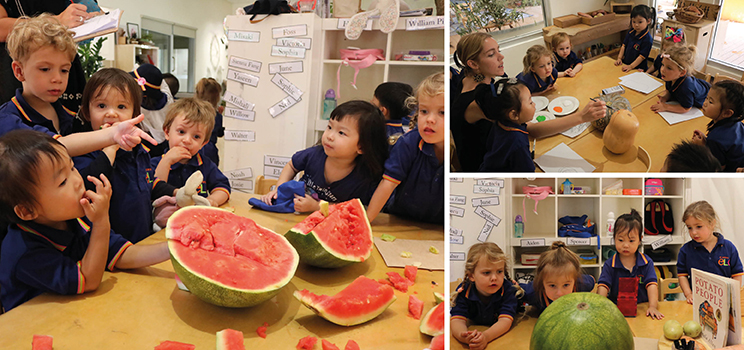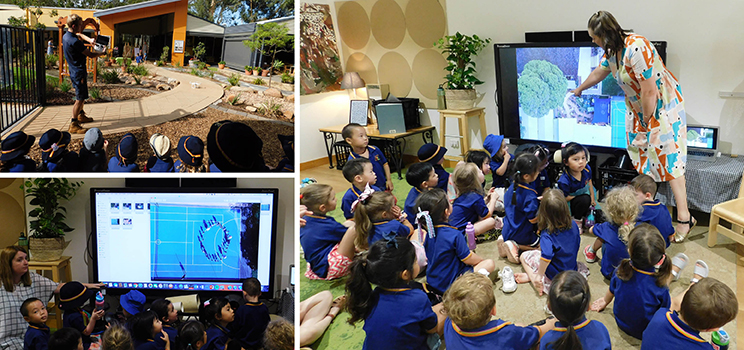From the Director of Early Learning
Dear Families

Thank you for supporting us with the first few weeks of term; listening to our requests, assisting us with establishing supportive transition strategies, keeping us informed about your child and sharing important information that enables us to provide the very best care.
As a teaching group, we are reflecting on our learning community model that was introduced at the beginning of the year. Whilst still in its very early stages some of our reflections include:
- Positive friendship groupings across the rooms
- Intentional groupings with the inquiry enabling quality delivery and active participation
- Greater collaboration between Educators including the allocation of extended planning times
- The sharing of staff skill sets across the Centre
- Inclusion of dance and Atelier spaces for all children across the Centre
- Greater use of all physical spaces within the Centre and beyond
- Stronger awareness of what a community is and how collaboration enhances this
- Increased parent voice, participation and partnership across the Centre
In addition we are always thinking of ways we can continue to improve our communities in terms of operational components, and at our upcoming extended staff meeting next week, the entire ELC team came together to offer some problem solving to these reflections. An essential component of any new model is time to implement and time to reflect. We are giving ourselves this time by ensuring we are enacting our ELC mission on a daily basis.
Everyone learning side-by-side as active participants in both teaching and learning, underpinned by mutually respectful relationships and guided by optimism and open mindedness.
We are utilising expertise from the School and beyond to further enhance our skill sets and deliver what is required to implement this model successfully.
I am sure you will agree that in five weeks we have travelled a distance and we can now look forward to further rewards of our hard work. I would like to acknowledge the extraordinary courage and commitment of my lead teachers who have navigated their way through challenges as true professionals. It is an honour to work in such a rigorous learning culture, not just for the children, but for the educators too.
We look forward to sharing a Twilight Family Picnic together with our community on Friday 15 March from 5pm on Chiverton Lawns. Please make sure this date is on your diary.
Kind regards
Kate Mount
Director of Early Learning
Save the Date
Friday 15 March: Friends of the ELC Twilight Family Picnic 5pm
Monday 25 – Wednesday 27 March: ELC Photos
Thursday 11 April: Friends of the ELC Easter Morning Tea 8.30am
Monday 15 April: Vacation Care begins
ELC Photos
This year, our ELC group and individual photos will be held on Monday 25 to Wednesday 27 March, from 9am – 12 noon.
Please ensure your child is wearing their ELC uniform on each of these days as they will potentially appear in multiple class shots, depending on the days they attend. Please also ensure your child’s hair is styled as neatly as possible.
You will be receiving a letter with more detailed information. If you have any questions or require further information, please contact me via kmount@stpetersgirls.sa.edu.au. As you can imagine, these photos will require a large amount of organisation and we appreciate your support and cooperation.
Kate Mount
Director of Early Learning
Welcome to Learning Community 1
Welcome to Learning Community 1. This term our central idea is ‘working together can create communities’. Watch the video above to see how we’re doing this in a number of intentional ways.
Accessing your Child’s Canvas Page
Your child’s Canvas homepage is a dynamic online sharing space that invites you to participate in your child’s learning as it happens. It provides a window into your child’s life at the ELC as educators share intentional teaching, specialist lessons and spontaneous moments.
We can share videos and images directly with parents that capture the rich learning experiences in which your child is engaged throughout their time at the ELC. The Canvas homepage also enables us to share more of the process of learning – rather than just the end product.
Your child’s Canvas page is accessed through the myLink Parent Portal. If you have not accessed your child’s Canvas page before, please follow the below instructions.
Accessing Canvas through the myLink Parent Portal:
To access myLink for the first time, please follow these simple steps:
- Visit https://mylink.stpetersgirls.sa.edu.au
- To set your first password, click the link below the sign in section
- Enter your username, click ‘Next’
- On the next screen, enter the security code emailed to you
- Enter the password you would like to use and press submit
- Return to the login screen at https://mylink.stpetersgirls.sa.edu.au to access myLink
- Several instructional videos are available via the Welcome page if you click on the “How to use myLink” tile.
If you have any problems accessing or navigating myLink, please contact the IT Helpdesk on 8334 2227 or email helpdesk@stpetersgirls.sa.edu.au.
Photo Etiquette:
Please note that your child’s Canvas homepage and Portfolio will contain some images and video footage of other children. We therefore ask that you do not copy or share images or videos, especially on social media, if they contain other children.
Signing in via iCheck-In
Last year, St Peter’s Girls’ Early Learners’ Centre introduced iCheck-In – new easy-to-use software that enables you to digitally sign in and out of our ELC, bringing us in line with updated Government regulations.
Please note, signing your child in/out daily using the iPad provided is a legal requirement. If you are having issues signing in/out, please ask an ELC educator to help you.
On your first login, you will be asked to enter your mobile phone number and a password will be sent via SMS which you will need to use every time you sign your child in or out of the ELC. Each family member will need to enter their own phone number and password when signing in/out, so please do not give your password to others.
Please refer to this instructional poster to familiarise yourself with the new procedure. This will also be on display next to the iPad when you sign your child in or out.
If you have any queries, please contact Sarah Elliott via 8334 2271 or selliott@stpetersgirls.sa.edu.au.
ELC Goes Egg-Free
We ask that you do not pack nuts or eggs or food containing these ingredients as we have children within our Centre who have severe allergies to them. We request that families be responsive to our requests when packing their child’s lunch box. We are also removing items containing eggs from the Tuck Shop menu.
We thank you kindly for assisting us to support all children and staff’s health and safety whilst in our care.
来自黄老师的信息
亲爱的家长朋友们,
关于食物过敏:
由于在ELC一些小朋友对鸡蛋和坚果类食物有严重的过敏反应,请家长们务必不要将此类食物放进午餐盒。
在我们ELC学习社区里,我们有ELC的老师们和来自圣彼得女校的老师们共同帮助我们英语作为第二语言的小朋友们的学习,找到更适合他们的学习方法。
另外请家长朋友们注意,您孩子的Canvas主页和在线学习档案可能会包含其他孩子的一些照片和视频片段。因此,我们希望家长不要复制和分享包含其他孩子的照片和视频,尤其是在社交媒体上。
3月15晚上5:00-7:00 ELC暮光野餐会 学校大草坪
Emma works in Learning Community 2 on Monday, Thursday, Friday from 9am – 5pm, and Jade works 11am – 6pm every day in Learning Community 1.
Symphony of Languages: Mapping and Dancing in Learning Community 2

The Symphony of Languages (SOL) team is working in collaboration to enrich and to extend children’s interests across the ELC. In Learning Community 2 the contamination of languages is tangible with the inspiring meeting of two separate focuses of investigation: maps and dance.
The cooperation between Mrs Caterina and Ms Sims created a learning experience that join the mapping skills of Ferguson friends with the joy of dancing together.
The Ferguson Room began an open dance floor to be investigated in its shape and architecture. The children created a map of Ferguson Room, then they decided where to dance and how to use the space of the Room.
The result have been a joyful performance that enabled the children to refine and to understand concepts like:
- the bird eye view (concept inspired by the Aboriginal Art)
- the spatial coordinates
- the symbolic representation of spaces and people.
The experience also promotes:
- observational skills
- cooperation
- Decision making
- Fine motor skills
The deep understanding of the architectural features and the engagement of the children was so evident that we will surely revisit the experience again to explore new layers and possibilities of learning.
The fusion of languages will be a key focus for the SOL team in the next weeks with more exciting experiences and learning opportunities across the ELC.
SOL Team
Learning Community 1
News from the Stonyfell Room

Niina Marni?
How are you?
This is Kaurna language that we have learned from Tamaru, a Kaurna Elder from the local community who has become a good friend and teacher for us here in the ELC. Tamaru visits us regularly. The children always know he is coming because they hear his clap sticks as he walks down the path from the School Office. Sometimes he calls every body together:
Ngunkana, miyana, ngunkana, miyana!
Boys and girls! Boys and girls!
The United Nations General Assembly has declared 2019 the International Year of Indigenous Languages to raise awareness of the crucial role languages play in people’s daily lives. In Australia, of the estimated original 250 Aboriginal and Torres Strait Islander languages, only around 120 are still spoken.
At Morning Meeting we always begin with an acknowledgement of the Kaurna people and land:
Niina marni,
We thank the Kaurna people for our land.
We welcome you to play with us
At the ELC and Ferguson Park.
Sharing the land, and the plants
We look after everything on the land, the people and the animals.
Then we greet each other in the Kaurna language. If we are feeling good, we reply ‘Marni ai’. If we are feeling a little bit sad or unwell we reply ‘Kuku ai’. In this way we are embedding the language and the respect for culture in our daily lives.
Last week, the ELC hosted 80 educators from all over South Australia. Tamaru was our guest speaker and after a Welcome to Country and a traditional smoking ceremony, we went together into Ferguson Park to share the way we work alongside of Tamaru to transform our relationship with the land and with Kaurna people. We are a progressive early learning site and others are extremely keen to visit us and to be inspired by our work.
Our efforts to learn and to experience Reconciliation with the first peoples of Australia are ongoing, not reserved for special occasions. Our children are, as they always are, our hopes for a bright future. A future where all people of Australia are walking together, sharing culture, language and a deep, authentic respect for one another.
Mel Angel
News from the Bell Yett Room

The ‘Atelier of Food’ in the Bell Yett room has become a significant communal space within Learning Community 1. Since the beginning of the term we have been using this space to investigate, prepare, share, and appreciate food together.
Every morning in the Bell Yett Room and across Learning Community 1 we eat watermelon and other fruits at morning tea. We have been wondering, do we know what these fruits look like before they are cut up on our plate? We decided to investigate further. Alongside our Atelierista Caterina Pennestri, we introduced a whole watermelon to the atelier as a provocation.
Through touch and observation, our children began to offer many interesting theories about the features of the watermelon:
“It’s a ball!” – Sonya
“It’s not food, it’s cold.” – Foss
“This is where the caterpillars go in to eat the red bits.” – Hudson
Investigating the watermelon introduced elements of scientific and mathematical thinking when we considered:
- The weight of the fruits and how to transport something heavy. We discovered quickly that this must be done by working together.
- The properties of a three dimensional shape and what each shape can and cannot do.
- Cutting the watermelon open to eat introduced simple fractions, when two halves were created from one whole.
Exploring the fruit from an artistic angle has allowed us to consider the theory of colour:
- Selecting and combining acrylic paints to progress from primary to secondary colours
- Color matching our paints to the fruit displayed
- Observing the fruit closely and making color comparisons
- Representing colour and texture with different art materials.
After a week of studying the watermelon, Danniella Capaldo and I then introduced two different types of pumpkins in the same manner. The children applied what they learnt with the watermelon, offered their theories and then began to colour match with the art materials provided. They studied the shape and began to attempt replicating it in their drawings. They anticipated that the inside was going to look different:
“It will be wet!” – Sienna Fitton
“Soft!” – Ava
Our fruit and vegetable inquiry will continue into the coming weeks, following a sustainable pattern of investigating, preparing and sharing. This will be done alongside of Sonia Samuel who has begun sharing some of her family recipes in our atelier. The children have started preparing roti, exploring a variety of different spices with their senses. Danniella Capaldo has been preparing vegetables alongside the children which are later roasted and eaten at late snack at the end of the day.
Each day at the beginning of our morning and afternoon tea ritual, we have been saying the word ‘Ngaityalya’. Taught to us by our Kaurna Elder Tamaru, we have learnt that it is a special Kaurna word meaning ‘respect for our food and for one another’, values that we have embedded into our Atelier of Food inquiries.
Annabelle Redmond
Learning Community 2
News from the Ferguson Room

How does technology invite collaboration?
We have a rich digital landscape across our learning community and have access to an array of technologies. We engage with this technology to enrich our inquiries and enhance our understandings.
This week the children in the Ferguson Room invited Liam Blanden from Property Services to come to the ELC and bring his drone. This was an exciting opportunity for the children to see the potential that technology can provide us and how it can enrich our inquiry. Liam worked with the children to show them what a drone was and how we can use it. During this experience we captured numerus images of the ELC from above and we even took a photo of us in a Palti Circle. The children were able to see straight away the images that were taken and we began noticing the details we could see:
- The path
- The mud kitchen
- The trees
- The mats
- Even us!
“There we are on the Tennis court” – Ariana
“Where would that path take us?” – Thomas
We are excited to work with these images over the coming weeks and we are already planning our next invitation for Liam to work with us again.
Using the drone added another layer to our developing inquiry and the educators could see the power that this technology had in capturing our imaginations and in providing us with images we can work with. The experience with the drone built on our social skills as we had to follow some rules when using it. We built on our communication skills as we shared ideas and wondering during this time. It allowed us to work together as a community of learners.
Laura Reiters
News from the Hallett Room

How do the children collaborate together to create a shared community garden?
“Gardening with my family is fun, we grow capsicum and basil that we pick and cook pasta for dinner.” – Alessia
Community is defined as a “feeling of fellowship with others, as a result of sharing common attitudes, interests and goals.” For children, a sense of community brings connection both to their surroundings and the individuals in those surroundings – further connecting them to their own unique place in the world.
Each day, as we gather together in our small groups to begin our investigations, the children have been bursting with excitement to share their individual photos, news and/or fresh produce they have bought from home or their grandparent’s homes. Our inquiry groups have supported the children to engage in discussions and develop theories about their home gardens and their family rituals.
“My grandma grows strawberries and tomatoes, we eat them off the tree” – Molly
“We make bolognaise sauce, we use tomatoes from our garden” – Lily
“We have green herbs and apples” – Tiara
“My tree has apples on it. Some are eaten by birds and ants. We picked some and ate them after dinner for dessert”– Amelie
“My grandma grows pumpkin to make dumplings” – Mathea
Planning a shared garden has enabled the children to strengthen their skills. This has included the:
- Development of confidence and independence
- Development of scientific and mathematical skills and knowledge
- Enhancement of cognitive and social skills
- Development of problem-solving and critical thinking skills
- Sharing and transferring knowledge
We have begun the planning stages by involving many stake holders throughout our school community. Jessie suggested we get Deb from the Tuck Shop because “she cooks yummy morning and afternoon tea and uses vegetables”. Elijah suggested we ask Mr Liam as he “looks after the garden in the school”. We invited Deb from the Tuck Shop for lunch, the children formed some questions.
“Do you cook with tomatoes?” – Florence
“What can we make with zucchini?” – Alessia
“Do you make pasta?” – Elly
“Where do your vegetables come from?” – Amelie
Elijah, Molly, Heidi and Eloise have mapped out a garden bed to share with Mr Liam in our meeting next week. “We need to plant in rows, or they will get tangled”, Elijah shared. “The hay near the plants keep them warm”, Molly informed us.
We would appreciate any parent participation in our project to design and create an edible garden. The final plan is to grow fruit trees, vegetables and herbs that we can use to cook throughout the ELC allowing the children to care for plants, learn about sustainability and the importance of caring for their environment.
Nell Tierney and Leanne Williams
